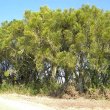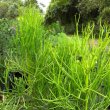Euphorbia tirucalli
| Botanical Name | Euphorbia tirucalli |
|||||||||||
| Family | Euphorbiaceae - The euphorbia family. |
|||||||||||
| Pronunciation | yoo-FOR-bee-uh tee-roo-KAL-ee |
|||||||||||
| Common Name(s) |
English: Pencil Plant; Rubber-hedge Euphorbia
Kraalnaboom; Kraalmelkbos
IsiXhosa: umhlontlo
IsiZulu: Umnduze; Umsululu
Sesotho sa Leboa: Motlalamela
Setswana: More-ômotala; Motsêtse; Sehlaresetala
Tshivenda: Mutungu
|
|||||||||||
| Plant Group |
|
|||||||||||
| Plant Size |
|
|||||||||||
| Position |
|
|||||||||||
| General Information |
|
|||||||||||
| Specific Information | Euphorbia tirucalli is a succulent tree or large shrub with thin, cylindrical, jointed branchlets, with single or multiple trunks. The main trunk and branches are straight, round, woody and brown to grey. The leaves are tiny and are shed early. The flowers are inconspicuous and hidden in a group of petal-like bracts (modified leaves) on the tips of the branchlets. The fruit is a roundish, pink capsule on a short stalk, which splits into 3 parts, revealing the seeds. This euphorbia was used extensively as a hedge around homesteads, the poisonous sap and the dense branching providing an effective deterrent. Euphorbia tirucalli will grow anywhere that the winters are not too cold. NOTE: As with other euphorbias, the latex is very toxic and may cause blindness, blisters on the skin, and death if enough of it is swallowed. |
|||||||||||
| Ad Break | ||||||||||||
| Flowers | ||||||||||||
| Description | inconspicuous |
|||||||||||
| Season |
|
|||||||||||
| Colour |
|
|||||||||||
| Growth Rate |
|
|||||||||||
| Plant Uses |
|
|||||||||||
| Distribution and Habitat | in the Eastern Cape, KwaZulu-Natal, Mpumalanga, Gauteng and Limpopo, and north to Ethiopia, in the warmer regions |
|||||||||||
| Planting Suggestions | Plant in a mixture of garden soil and compost. Mulch to retain moisture. Good drainage is essential. The old method of digging a deep hole and filling it with soil and compost has resulted in many trees failing to thrive, dying, rotting at the base or worse still, falling over in later years due to poor root development. Refer to the following sites for the best method of planting trees: International Society of Arboriculture: New Tree Planting Tree People: Plant the right way For those of you who have a clay problem try: |
|||||||||||
| Medicinal Uses | This useful tree has been frequently used as a hedge around kraals and homes, hence its common name. A fish poison is also made from this euphorbia. |
|||||||||||
| Ad Break | ||||||||||||






Discuss this plant
Share knowledge, ask a question or give an experience.